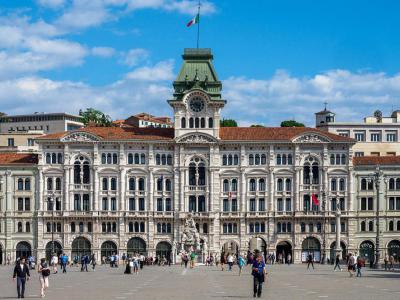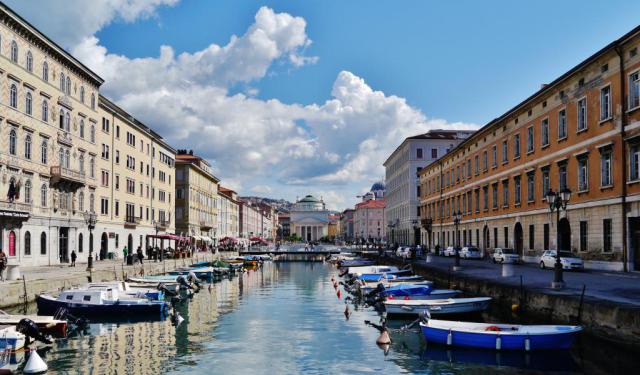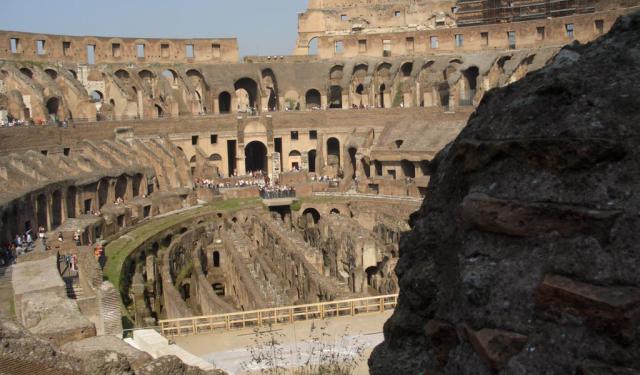
Palazzo del Municipio (City Hall), Trieste
Located in the Square of Italian Unity, the City Hall is the seat of the Municipality of Trieste. In the late 19th century, the old Palace of the Magistrate was demolished to make way for the new municipal building. Trieste architect Giuseppe Bruni, who had formerly designed the Modello Palace, was chosen for the City Hall.
Engineer and architect Eugenio Geiringer was the director of the project, which was completed in 1875. The facade, facing the square, is Eclectic in style. It has two side bodies of four floors and a central body of five. The grand floor has portico or gallery-like arches. Upper floors have mullioned windows.
In the center, atop the clock tower, two bronze statues of Moors, nicknamed "Micheze" and "Jacheze" (from Slovenian Mihec and Jakec), guard the bell. Giuseppe Bruni installed the Moors. They are in memory of the two who struck the chimes on the Mandracchio Tower, the former Gateway to the port, demolished in 1838.
The original Moors, sculpted by Fausto Asteo da Ceneda, were installed in January 1876. They were replaced by copies in 1972 while being restored. In 2004 the refurbished statues were set up at the entrance of San Giusto Castle.
On a stage in front of the building in 1938, the dictator Benito Mussolini announced his hateful racial laws. This disaster was corrected in 1954 as the mayor of the city, Gianni Bartoli, announced celebrations marking the return of Trieste to Italy.
Engineer and architect Eugenio Geiringer was the director of the project, which was completed in 1875. The facade, facing the square, is Eclectic in style. It has two side bodies of four floors and a central body of five. The grand floor has portico or gallery-like arches. Upper floors have mullioned windows.
In the center, atop the clock tower, two bronze statues of Moors, nicknamed "Micheze" and "Jacheze" (from Slovenian Mihec and Jakec), guard the bell. Giuseppe Bruni installed the Moors. They are in memory of the two who struck the chimes on the Mandracchio Tower, the former Gateway to the port, demolished in 1838.
The original Moors, sculpted by Fausto Asteo da Ceneda, were installed in January 1876. They were replaced by copies in 1972 while being restored. In 2004 the refurbished statues were set up at the entrance of San Giusto Castle.
On a stage in front of the building in 1938, the dictator Benito Mussolini announced his hateful racial laws. This disaster was corrected in 1954 as the mayor of the city, Gianni Bartoli, announced celebrations marking the return of Trieste to Italy.
Want to visit this sight? Check out these Self-Guided Walking Tours in Trieste. Alternatively, you can download the mobile app "GPSmyCity: Walks in 1K+ Cities" from Apple App Store or Google Play Store. The app turns your mobile device to a personal tour guide and it works offline, so no data plan is needed when traveling abroad.
Palazzo del Municipio (City Hall) on Map
Sight Name: Palazzo del Municipio (City Hall)
Sight Location: Trieste, Italy (See walking tours in Trieste)
Sight Type: Attraction/Landmark
Guide(s) Containing This Sight:
Sight Location: Trieste, Italy (See walking tours in Trieste)
Sight Type: Attraction/Landmark
Guide(s) Containing This Sight:
Walking Tours in Trieste, Italy
Create Your Own Walk in Trieste
Creating your own self-guided walk in Trieste is easy and fun. Choose the city attractions that you want to see and a walk route map will be created just for you. You can even set your hotel as the start point of the walk.
Trieste Introduction Walking Tour
Sub-tropical Trieste lies on a bit of land between the Adriatic Sea and Slovenia. Savannas, forests, and karstic areas of sinkholes and caves surround the coastline. It is a deep-water port and a major gateway to northern Italy. It is called "Vienna by the Sea" by some or "City of Coffee" by others.
The ancient Veneti tribes called the town "Tergeste," which means... view more
Tour Duration: 2 Hour(s)
Travel Distance: 3.7 Km or 2.3 Miles
The ancient Veneti tribes called the town "Tergeste," which means... view more
Tour Duration: 2 Hour(s)
Travel Distance: 3.7 Km or 2.3 Miles
Trieste's Ancient Roman Sites Walking Tour
The Roman remains on Trieste extend along the northwestern slope of San Giusto Hill, overlooking the Gulf of Trieste. Wharves of sandstone slabs dating from the 1st century AD were found by the Roman Theatre. The city walls, ordered by Augustus, were converted to use as terraces.
The Propylaeum of the 1st century AD was the gateway to the sacred area of the Capitoline Temple. There are two... view more
Tour Duration: 1 Hour(s)
Travel Distance: 0.9 Km or 0.6 Miles
The Propylaeum of the 1st century AD was the gateway to the sacred area of the Capitoline Temple. There are two... view more
Tour Duration: 1 Hour(s)
Travel Distance: 0.9 Km or 0.6 Miles


